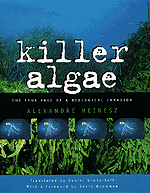
Killer Algae
Alexandre Meinesz
Translated by Daniel Simberloff. 360 p., 8 color plates, 5 line drawings, 7 maps. 1999.
The University of Chicago Press
Cloth $US 25.00 0-226-51922-8
Review from University of Chicago Press website. Visit there for more information.
Two decades ago, a Stuttgart zoo imported a lush, bright green seaweed for its aquarium. Caulerpa taxifolia was captively bred by the zoo and exposed, for years, to chemicals and ultraviolet light. Eventually a sample of it found its way to the Oceanographic Museum in Monaco, then headed by Jacques Cousteau. Fifteen years ago, while cleaning its tanks, that museum dumped the pretty green plant into the Mediterranean.
This supposedly benign little plant -- that no one thought could survive the waters of the Mediterranean -- now covers 10,000 acres of the coasts of France, Spain, Italy, and Croatia, and has devastated the Mediterranean ecosystem. And it continues to grow, unstoppable and toxic. When Alexandre Meinesz discovered a square-yard patch of it in 1984, he warned biologists and oceanographers of the potential species invasion.
His calls went unheeded. At that point, one person could have weeded the small patch out and ended the problem. Now, however, the plant has defeated the French Navy, thwarted scientific efforts to halt its rampage, and continues its destructive journey into the Adriatic Sea.
Killer Algae is the biological and political horror story of this invasion. For despite Meinesz's pleas to scientists and the French government, no agency was willing to take responsibility for the seaweed, and while the buck was passed, the killer algae grew. In short, Killer Algae -- part detective story and part bureaucratic object lesson--is a classic case of a devastating ecological invasion and how not to deal with it.
• Review from University of Chicago Press website. Visit there for more information.
• See page about Caulerpa taxifolia introductions worldwide.
Rudman, W.B., 2000 (July 16) Killer Algae. Alexandre Meinesz . [In] Sea Slug Forum. Australian Museum, Sydney. Available from http://www.seaslugforum.net/factsheet/brcaulerpa
